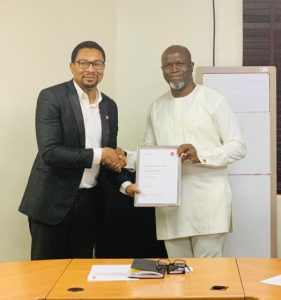Saving Pregnant Women’s Lives in Gombe Northeast Nigeria – Using New Tools for Blood Pressure Monitoring and Community Health Workers.

Despite availability of effective solutions, Nigeria’s maternal deaths continues to be one of the highest in the world. It has been about the same level since 1990. Poor access to effective obstetric interventions contributes to this.
In Gombe State northeast Nigeria, about 14% of women have a live birth each year. Of these, we estimate that about 2,000 die because of disorders related to their pregnancy. Hypertension-related disorder alone accounts for about 30% of these deaths.
Innovation to turn things around
In December 2018, the Society for Family Health (SFH) and Gombe State Primary Health Care Development Agency (GSPHCDA) trained 412 Village Health Workers (VHWs) for two days on the community monitoring of hypertension in pregnancy. They showed the VHWs how to use a semi-automated blood pressure (BP) measuring device to do this. The training included about 12 hours of classroom sessions and field work. Each VHW received a semi-automatic BP machine after the training and was sent back to her community to monitor pregnant women’s BP and refer abnormal cases based on the readings on the device to identified health facilities. The innovation is part of a broader strategy by SFH to increase coverage and access to quality obstetric health care in Gombe State.
The VHWs are literate members of the communities they live and work in. They have been in operation since November 2016 and provide basic health promotion and preventive services to pregnant women and newborns in their communities through scheduled home visits. They each receive a stipend of N6000 per month – now funded 100% by Gombe State government.
Jemila Abdusalam, a 40-year-old VHW who doubles as a health attendant in Bogo Model PHC in Akko LGA, is excited about her new capabilities and the BP device. She said “it (the BP device) has helped me reach more pregnant women. Since I started using it… they (pregnant women in her community) all want their blood pressure checked. It makes reaching them easier for me. They are more welcoming now,”. She believes the “intervention is ensuring the provision of better pregnancy care for poor pregnant women who can’t afford the cost of transportation to go to a health facility for ANC,”.
Coverage
Although health investment in the primary health care sector has increased in Gombe State, only slight improvements in the coverage and utilization of life-saving interventions for pregnant women has occurred since 2012. While about 60% of pregnant women in the State have their BP checked at least once during pregnancy, most (70%) still deliver their babies at home. They do so most times with no one present and no equipment to monitor their vital signs. This puts them at risk of preventable deaths.
Expanding the VHWs’ scope of work to include monitoring of pregnant women’s blood pressure through house to house visits is a significant milestone for the government of Gombe. It is in line with the aspiration for universal health coverage in the State.
The VHWs visit hard to reach communities where pregnant women are least likely to have access to essential care. This means the community-based innovation ensures that those most likely to be at risk of poor access to healthcare get it.
On the average, each VHW visits and registers about eight pregnant women per month. They visit the registered pregnant women at least four times – once a month – during that pregnancy. The VHWs provide the pregnant women a package of obstetric and newborn health services during each of the visits. They educate pregnant women about obstetric and newborn danger signs, ask for complaints associated with the pregnancy and/ or newborn, assess obstetric danger signs, check pulse and BP using the semi-automatic blood pressure measuring device, counsel, and encourage the pregnant women to continue to use health facility based obstetric and newborn services during the pregnancy and postnatal period. They also assess newborns’ nutritional status and breast feeding pattern.
The VHWs refer pregnant women with abnormal BP readings or other obstetric danger signs, and ill newborns to health facilities right away, when found. Most times, the VHWs escort these pregnant women with “danger signs” to health centers to ensure they access obstetric and/or newborn care. We expect the 412 VHWs implementing the BP innovation to reach about 13,500 new pregnant women over the next four months.
The BP Measuring Device
The BP measuring device is hand held and has a cuff applied to the upper-arm. It comes with two cuffs–a standard and a large. The manufacturers of the devices designed the large cuff for obese clients. The standard one should fit the generality of the population.
The device is semi-automated, and it measures both BP and pulse. It has a traffic light early warning system to alert VHWs of vital signs abnormalities – making it suitable for use by low literate people. It has low power consumption and can be used on about 200 pregnant women when the battery is full. The device is qualified by standard validation protocols.
“The device works well, and it is easy to use. I like the beep sound it makes… it helps me know when to start and stop inflating the cuff. It is also easy to recharge the battery, and it hasn’t given me any trouble since I have been using it,” Gambo Ibzan, a VHW in Akko LGA.
Gambo believe the device has increased her profile in the community. “Now they (pregnant women) call me a doctor and even come to my house to ask to check their BP,” she added.
Sustainability of the Innovation
The scale up of the innovation across the state is important to GSPHCDA because it will contribute to averting about 650 of 2,200 maternal deaths every year. The government has also put aside money to guarantee 100% payment of the VHWs’ stipend beyond the life of SFH’s support.
In addition, the GSPHCDA is rebranding the VHW scheme to align with national health aspirations. Processes are being perfected to expand their mandates to Community Health Influencers, Promoters, and Service (CHIPS) providers. The CHIPS program is a brainchild of the National Primary Health Care Development Agency, which like the VHW scheme, aims to improve universal health coverage of essential interventions in Nigeria. The alignment of the VHW scheme as CHIPs further strengthens its institutionalization and provides national support for it.

Shobo Olukolade George
The Society for Family Health is supporting GSPHCDA to learn about the feasibility, facilitators, and barriers to the effective implementation and scale up of the innovation statewide. The coverage and reach of the innovation, and how it is contributing to saving the lives of pregnant women in Gombe will be answered through the learnings.
Ultimately, sustaining the intervention and making the scale up a reality will take continued demonstration of strong political will for the VHW scheme by subsequent governments. Strengthening the health governance structure of GSPHCDA and integrating the VHW program into the routine business of government is key.
The Society for Family Health continues to aim at improving health outcomes through effective coverage of life-saving interventions in Nigeria. The organization is now engaging the new government in Gombe State – to save lives of pregnant women and newborns in the state.
– Shobo Olukolade George


